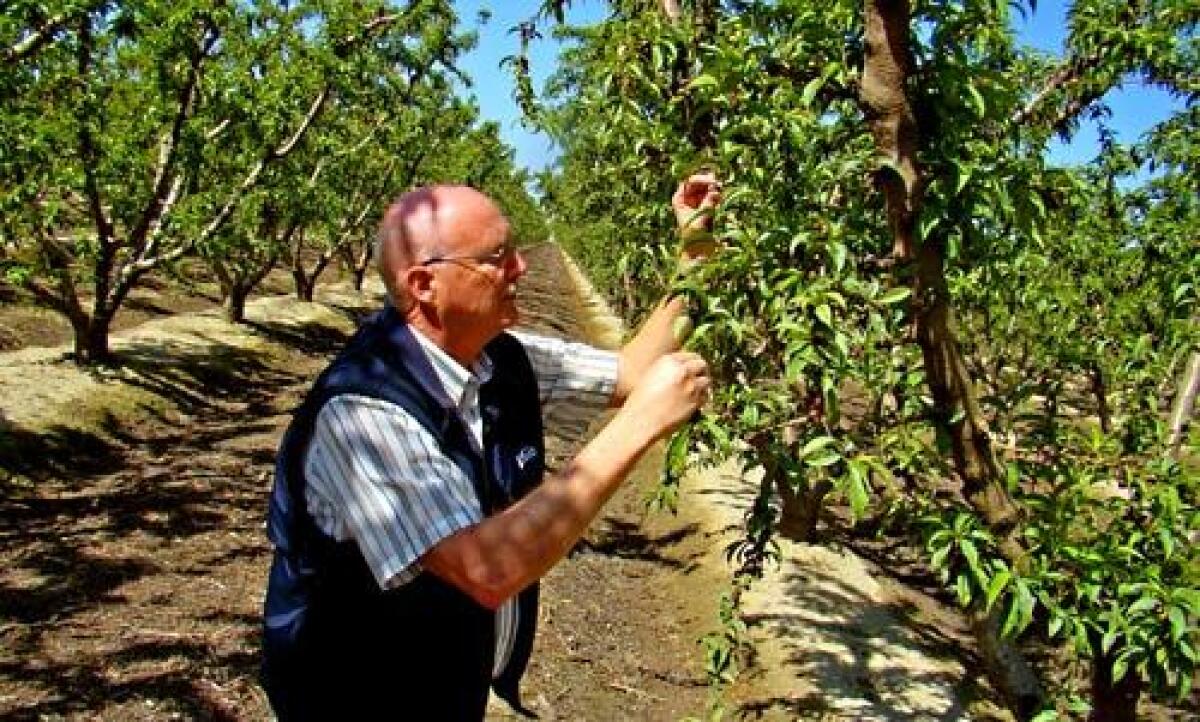Fresno County Fruit Trail offers a fresh bounty of sweetness

- Share via
The last of the fragrant fruit blossoms is gone, their pink-and-white petals scattered across the orchards that nestle among the verdant foothills of the High Sierra.
By month’s end — the first strawberries will be ready for picking. The blackberries and blueberries won’t be far behind. In May, apricots, plums and other stone fruit will begin to ripen.
The shutters will disappear from the roadside stands. Their colorful displays of sun-sweetened delights will beckon drivers to stop and sample fruits as varied as cherries and pomegranates.
Many of the stands are along the Fresno County Fruit Trail, created six years ago to showcase the county’s bounty. It’s among the top U.S. producers of peaches, nectarines and plums. Fruits and nuts pump about $2.5 billion a year into the local economy.
The Fruit Trail — along with its cousin, the springtime Blossom Trail — invite visitors to an area they might otherwise ignore on their way to nearby Kings Canyon and Sequoia national parks.
“We don’t realize what treasure California agriculture is. It’s the state’s heartbeat,” says Stacey Grote, operations manager at Simonian Farms on the outskirts of Fresno. The first stop on the Fruit Trail, the farm has been popular with locals since 1901 for its produce and, more recently, its ever-growing collection of antiques, including several vintage tractors.
“People need to be educated on where our fruit comes from and what it tastes like when it’s fresh off the farm,” Grote says. “It’s hugely different.”
Before leaving Simonian, visitors should grab a free copy of the detailed map and guide to the Fruit Trail. The route winds through towns such as Sanger, Kingsburg and Reedley — and even strays a few miles into neighboring Tulare County.
“[California’s tree fruit] is almost all grown within 30 miles of Reedley,” says Gordon Wiebe, whose 600 acres of peach, plum and nectarine trees thrive in the ideal soil and climate. He also has 80 acres of olive trees.
Yes, the olive is a fruit, not a vegetable. With its stone, it’s a close relative of peaches and plums. So, as Wiebe tells visitors, the extra-virgin Bari olive oil he bottles in Dinuba is actually fruit juice.
Slowly, Wiebe is shifting the emphasis from the more familiar fruits to super-high-density olives, which, thanks to new technology, can be harvested by machine. His other fruit must be picked the old-fashioned way — by hand.
“It hasn’t changed since Eve picked the fruit that delighted her eye in the Garden of Eden,” he observes. “The picker has to look at the fruit and decide if it’s ready to be picked, or not.”
Wiebe’s nectarines aren’t forbidden fruit, but they’re sinfully expensive to harvest.
“We employ about 300 seasonal workers to pick and pack our 600 acres of tree fruit,” he explains. “If that was all olive trees, it would take about 15 people.”
Besides stops at about 20 growers, the Fruit Trail includes other interesting points. Among them is the Art Stand, near the hamlet of Minkler.
Appropriately located in a former produce stand on the highway to Kings Canyon National Park, the Art Stand features the works of 14 artists from the central San Joaquin Valley. Several pieces depicting stunning fruit tree blossoms are prominently displayed.
On the counter just inside the door sit copies of “Savoring Minkler,” a booklet by Sally Delap-John, who grew up just down the road. The small paperback contains her paintings of the nearby countryside, including several of grapes on the vine and of oranges being harvested — by hand, of course.
The booklet also contains the artist’s musings about life in her small, close-knit community. Delap-John also shares some of her favorite recipes for treats such as blackberry pie and persimmon cookies.
Just a peach pit’s toss away is the Cedar View Winery, run by Orange County transplants Jim and Debbie Van Haun. Visitors can taste their award-winning wines, including the delightful Alicante Bouschet, while savoring the eastward views over their vineyard to the snow-capped mountains beyond.
The wines are made on the first floor of an old barn the couple converted in 2003. Upstairs, sharing the same spectacular view, is the Winemaker’s Suite, one of three rooms they rent to overnight guests.
Besides dozens of varieties of fresh fruit, many farm stands sell jams, juices and other related products. In Minkler, a tiny stand sells soap made with pomegranate pulp; it smells like a sweeter version of the tart fruit.
Maybe best of all, with no middleman’s markup, the prices for fresh-as-you-can-get fruit are true bargains. At Simonian Farms, an 8-pound bag of navel oranges sells for $1.99. That’s 25 cents a pound for produce that, even when it’s on sale, can cost four times as much in supermarkets. To prove it, Stacey Grote posts the grocery ads inside the market.
“We’re always significantly less,” she says.
More to Read
Sign up for The Wild
We’ll help you find the best places to hike, bike and run, as well as the perfect silent spots for meditation and yoga.
You may occasionally receive promotional content from the Los Angeles Times.






